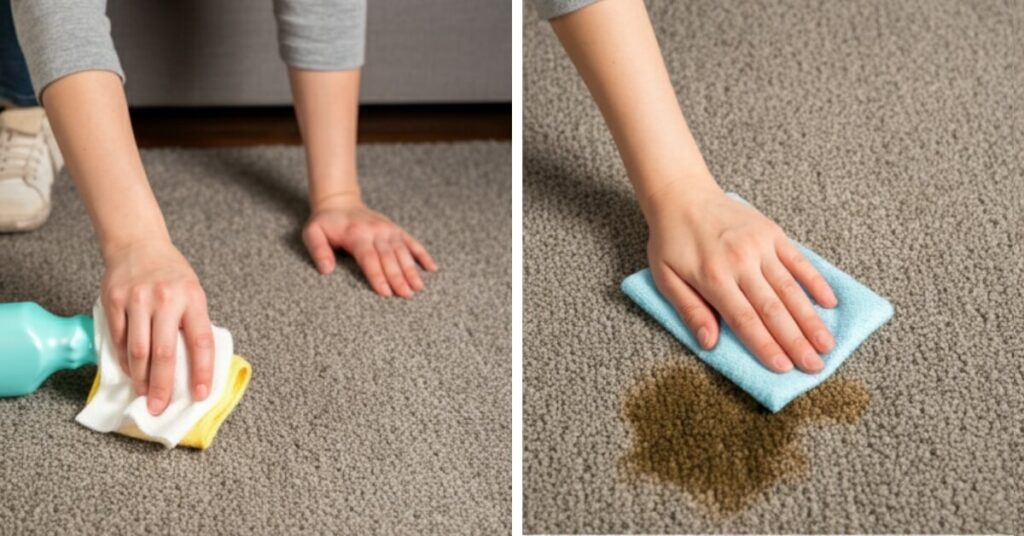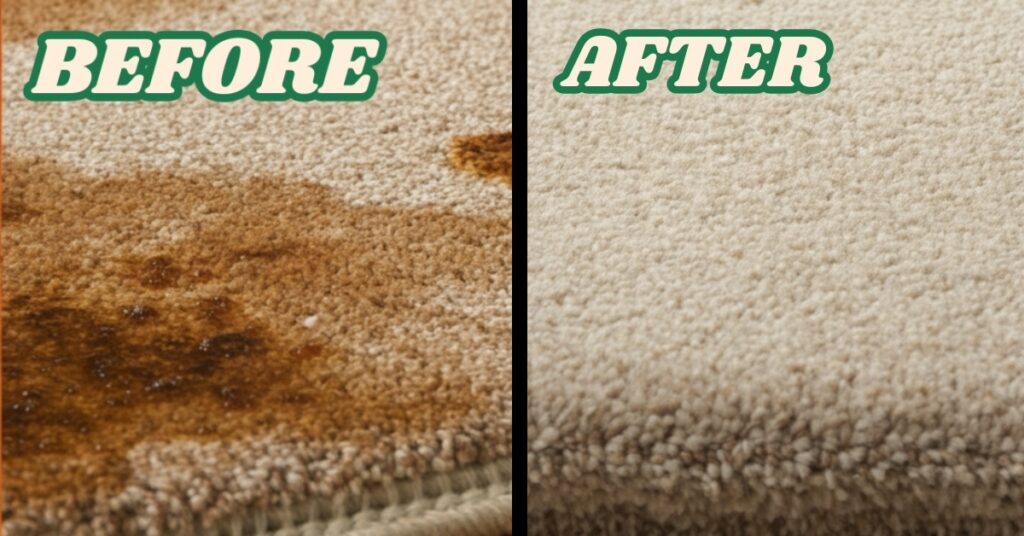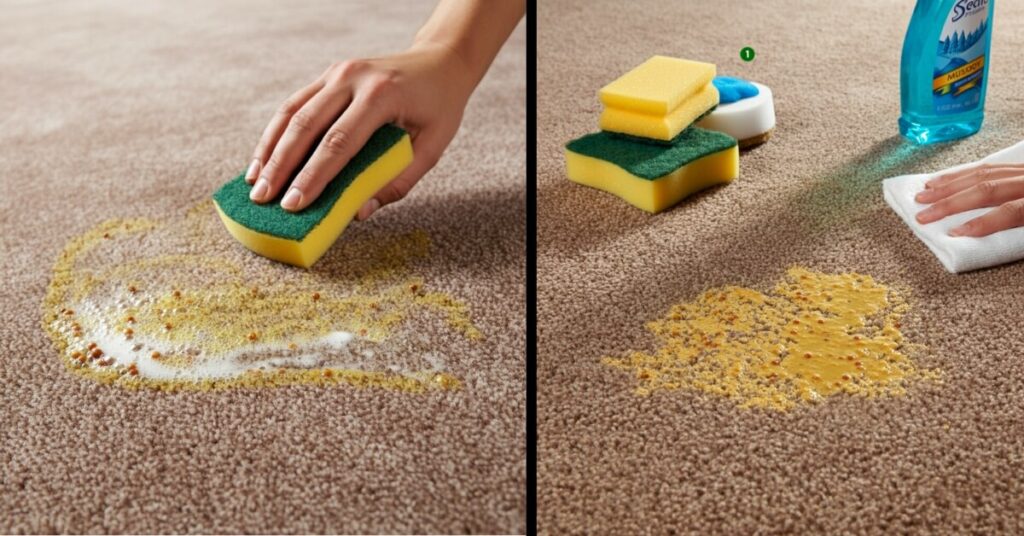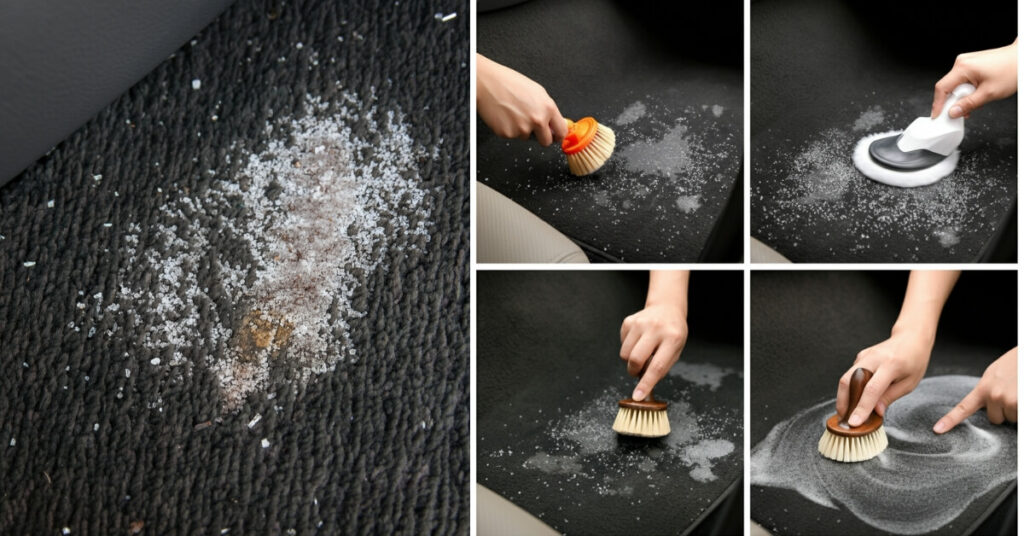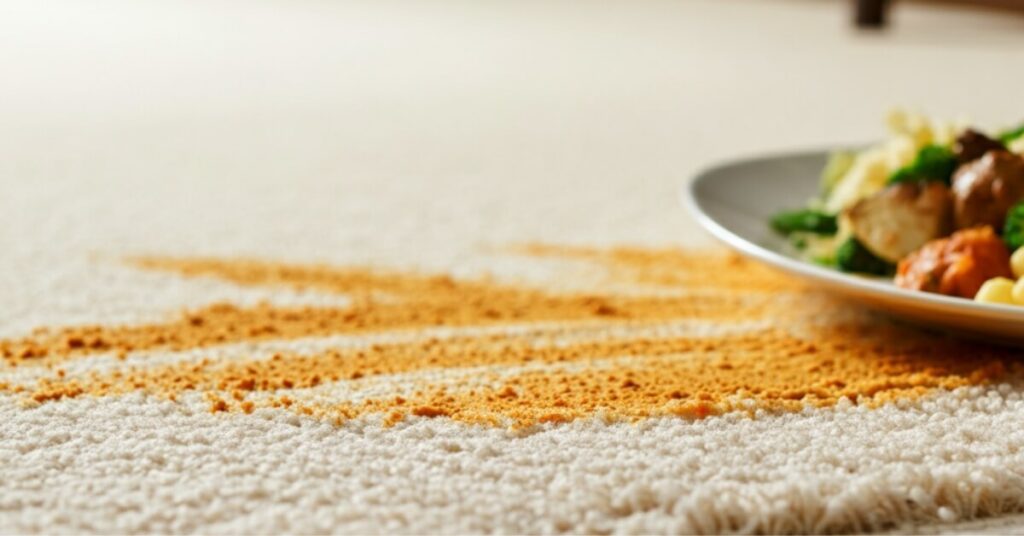As an Amazon Associate, I earn from qualifying purchases.
Yes, you can effectively remove pet stains from wool carpet with the right techniques and products. Wool is a delicate natural fiber, and improper cleaning methods—especially for pet-related messes like urine, vomit, or dirt—can cause permanent damage. Knowing how to clean pet stains from wool carpet correctly is essential for preserving its appearance and longevity.
This guide offers simple, effective steps tailored to wool carpet care. You’ll learn how to safely treat common pet stains, which products to avoid, and what methods work best without harming the fibers. Whether the stain is fresh or set-in, these techniques will help restore your carpet without risking discoloration or shrinkage.
Contents Overview
Why Do Wool Carpets Need Special Care?
Wool carpets are valued for their remarkable softness, strength, and natural beauty. However, these traits also make wool flooring sensitive in comparison to other types of flooring. Cleaning wool incorrectly is often disastrous. Here are a few reasons wool requires more caution:
1. Natural and absorbent
Spills and pet accidents are quickly absorbed by wool, making them absorbent by nature and difficult to remove if not treated timely. Wool is a protein-based natural fiber, so left untreated, the stains can penetrate deep into the fibers. Moreover, wool’s capacity to absorb liquids means that too much cleaning solution or moisture can dangerously seep into the backing, creating the risk for mold or mildew.
2. Sensitivity to Chemicals
Many synthetic carpets are not as sensitive to harsh chemicals as wool carpets. These cleaning agents, such as bleach, ammonia, and alkalis, can attack keratin, which is a protein that wool contains, resulting in the dulling of spots, disfigurement of the colors, and even damage to the fibers’ structure. To escape these effects, one must use pH-neutral products or ones specifically designed for wool.
3. Risk of Shrinking, Warping, and Felting
Wool is sensitive to extra heat and moisture. If over-watering occurs alongside poor drying conditions, steam, or heat, it can lead to carpet shrinkage or misshapenness, such as felting, where the fibers tend to clump together.
4. Stain Retention and Odor
Urine from pets contains several components, including proteins, uric acid, salts, and even bacteria. These things can become trapped within the wool fibers. If not treated promptly and thoroughly, pet urine can cause yellowing, long-lasting pungent odors, and become food for bacteria.
5. Sensitivity To Color And Texture
Last but not least, the coloring of wool often uses natural or low-impact dyes that are sensitive to strong cleaning agents and, sometimes, the sun over long periods of time. Because of this, there is an increased chance of uneven coloring after improper stain treatment.
How to Clean Pet Stains from Wool Carpet (Step-by-Step Cleanup Guide)
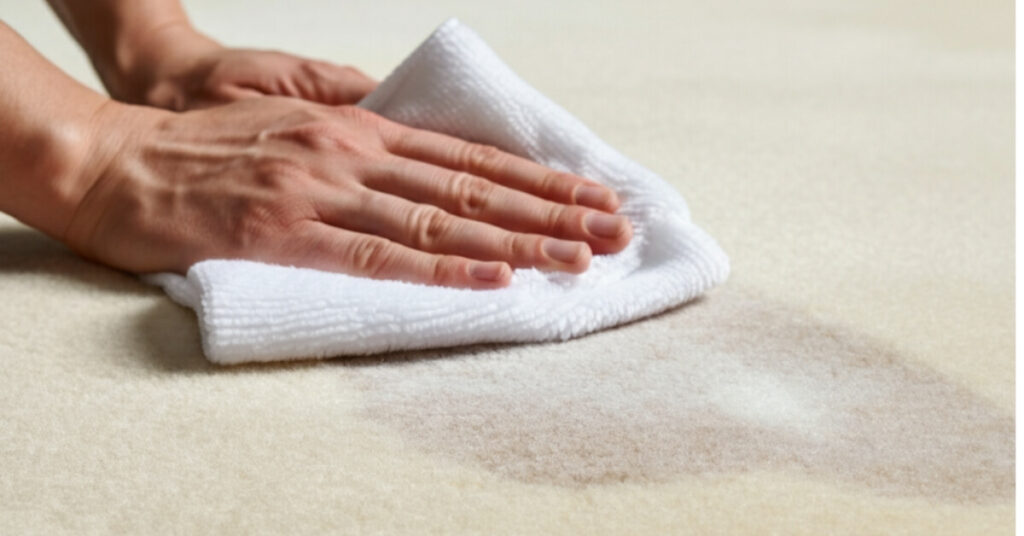
Stains caused by pets will be much easier to remove if addressed immediately. Here’s a soft yet effective method for dealing with all kinds of pet messes:
Step 1: Pat The Stain Area With Blotting Using Dry White Cloth
- For liquid stains such as urine, speed is paramount. Take a clean white cloth or a thick stack of paper towels.
- Blot the area and do not rub. Rubbing and scrubbing is counterproductive and will only push the mess deeper and distort the pile.
- Apply gentle but steady pressure. Let the cloth soak up as much liquid as possible.
- If the spill is huge, standing briefly on the towel will help a bit before switching to dry areas of the cloth as needed.
Example: During the night, if your furry friend happens to have an accident, you can use a white cotton towel to soak up all liquid that you find, rotating to a clean side each time.
Step 2: Remove Any Solids
In case your furry friend leaves any solid waste such as vomit or feces, you can scoop it up with a spoon, spatula, or a blunt knife. Scrape gently from the edge while moving inwards to prevent spreading the mess.
- Do not mash solids into the carpet fibers or the surface.
- Dispose of the material safely, and continue to blot the area in order to remove liquid residue.
Tip: Use disposable gloves for hygiene.
Step 3: Prepare a Mild Cleaning Solution
For the majority of stains caused by pets, we recommend the following options:
- Vinegar solution: Mix 1 part of white vinegar to 3 parts of cold water. Vinegar helps neutralize odor and break down organics without harming wool.
- Wool-Safe Cleaner: Use a product designed specifically for wool; follow label directions in terms of dosage and be sure to dilute appropriately.
- Mild Dish Soap Mix: A drop of unscented, dye-free, gentle dish soap in a cup of cold water is a last resort.
Never pour the solution directly on the carpet. Instead, apply the solution on a damp cloth and blot the stained area.
Step 4: Stain Treatment
- Soak a white cloth or microfiber towel in your cleaning solution.
- Wring it out so the cloth is damp and gently press it against the spot.
- To avoid spreading, work from the edge of the stain inward.
- Use light dabbing, and do not scrub or make circular motions.
If the stain is stubborn, let the solution sit for a few minutes, then blot and repeat as needed. For a hidden dog urine stain that you smell rather than see, dampen the area with diluted vinegar. Dab with a cloth until the area is no longer discolored and the odor is less.
Step 5: Stain Rinsing
Gently unsoak the area to eliminate any residue from the cleaning solution.
- Grab a new and clean garment, moisten it with cold water, and rinse the affected area by blotting lightly.
- Switch to the dry area of the gauze and continue blotting until the residue is soap-free and untraceable.
- The goal is to achieve no oversaturation. The dampened area should be present only to wipe off soap remnants.
Step 6: Blot Dry and Air Dry Completely
- Place a clean towel over the treated area and press to soak up excess moisture.
- To achieve the best results, leave the towel on for 10 to 15 minutes while applying some lightweight lotion on top.
- Once the moisture-absorbing towel is removed, allow the area to dry completely. For better results, opening windows or using fans can enhance ventilation.
Do not use hairdryers or any heat source to dry the carpet, as it can shrink or damage wool. If the weather is good, propping up the edge of the carpet can be helpful so that air can flow underneath it.
Tip: Look for any remaining moisture after a few hours. Wool that is wet has the potential for mildew to grow if not dried properly. Learn how to dry carpet after cleaning from our guideline.
Best Cleaners For Wool Carpets
When dealing with stubborn pet stains, using products made specifically for wool carpets is the safest option. Here are the most effective types:
1. Wool-Safe Carpet Shampoo
These shampoos are pH-balanced, chemical-free, and certified safe for animal fibers. Recommended Product: The Host Dry Carpet Cleaner for Wool, this powder-based cleaner gently lifts tough stains without overwetting.
2. Diluted White Vinegar
Vinegar eliminates odor caused by pets and is pet-friendly to a certain level. Always dilute with cold water in a ratio of two to three to avoid overwhelming the wool with its odor.
3. Enzyme Cleaners Safe for Wool
Cleanup products that contain enzymes work well to break down the proteins and organic waste found in urine, feces, and vomit from pets. Be sure to check the label that says “wool-safe” before using it on any wool material. Suggested Product: Rocco & Roxie Stain and Odor Eliminator is a wool-safe option that removes stubborn stains and odor.
4. Combination of Cold Water and Mild Dish Soap
An unscented dish soap diluted in cold water can safely remove minor stains.
5. Protective Carpet Sprays
Marks from stains that have not yet happened will be prevented from settling, thanks to the application of a stain guard designed specifically for wool carpets. Suggested Product: Scotchgard Rug and Carpet Protector – Safe for fine wool carpets and easy to use, applying it is a simple task.
6. Other Natural Cleaning Methods
For people who prefer approaches that do not include chemicals, a mixture of water with a bit of lemon juice will do the trick (always test first on a concealed surface area).
How to Protect Wool Carpets from Pet Stains

Preventing damage is often easier than fixing it! Here’s how to maintain the beauty of your wool:
1. Respond Immediately
The quicker you deal with spills or accidents, the better. Damage increases over time, as the likelihood of stains and odors increases.
2. Avoid Harsh Chemicals
Wool is a delicate fabric, and using bleach, ammonia, alkaline detergents, or high-pH spot removers will weaken the fibers.
3. Use as Little Moisture as Possible
Too much moisture can damage wool carpets by causing them to shrink or buckle. Always use a conservative approach when applying cleaning products.
4. Always Have Wool Safe Cleaners on Hand
Order enzyme cleaners and protectant sprays well before expecting to use them. Storing them in cool, dry places ensures they are ready when emergencies arise.
5. Take Protective Steps
Washable pet mats can be placed in areas where pets commonly lie down. Additionally, training pads can help during the training period for puppies and kittens.
6. Trim and Groom Pets Regularly
Regular grooming and bathing help reduce shedding and dander, making it easier to maintain clean carpets.
7. Keep to Minimal Areas
Restrict food and water bowls, litter boxes, and other pet activity to zones with simple-to-clean surfaces.
Conclusion
Removing pet stains from a wool carpet is manageable to clean with the right gentle methods, suitable cleaning products, and a bit of time. Moving done quickly and cleaning with care helps wool carpets. Cleaning mistakes need to be avoided. Using cleaning vinegar and wool-safe options, such as enzyme cleaners and specially formulated carpet shampoos, helps keep carpets clean without harming them.
Taking proactive measures also helps prevent issues during pet ownership, such as adding protective padding and reliable treatments for wool carpets, along with portable cleaning supplies. Smart care for wool carpets ensures comfort and quality design for years, even with pets around.
FAQs
1. Can I use baking soda on wool carpet?
In moderation, carpet baking soda is safe and can freshen pet odors as well as elevate light stains. Gently sprinkle over targeted spots and let rest for 15 minutes before thorough vacuuming. Vacuuming should be done gently to avoid fiber roughening.
2. Will enzyme cleaners damage wool?
Many enzyme cleaners are safe for wool, but only use those labeled specifically for it. Always check the manufacturer’s instructions and test in a hidden spot to ensure no discoloration or texture change.
3. How do I remove old pet urine smells from wool carpet?
Treat old odors by applying a wool-safe enzyme cleaner and letting it sit per product directions. Follow with a light vinegar rinse if needed. Persistent odors may require two or three treatments, but patience pays off.
4. Is steam cleaning safe for wool carpets?
Avoid steam cleaning wool. The combination of heat and high moisture can shrink, or distort the carpet’s shape. Stick to the step-by-step blot, dab, and air dry method described above.
5. Should I call a professional carpet cleaner for tough pet stains?
Yes. If stains are large, repeated, or have been left untreated for a long time, a certified professional will have wool-specific tools and cleaning agents to restore your carpet safely.
6. What should I do if the stain comes back after drying?
Reappearing stains—called “wicking”—are common when deep soiling works its way to the surface as the carpet dries. Repeat the blotting and dabbing process, then weigh down a towel with a heavy book overnight to absorb all lingering moisture.
7. Can I use hydrogen peroxide on wool to remove stains?
Hydrogen peroxide can bleach or damage wool fibers, so it isn’t recommended. Stick with gentle, pH-neutral solutions designed for natural fibers and labeled “wool-safe.”
8. What’s the safest vacuum for wool carpets?
Use vacuums with adjustable height settings and no beater bar or with a gentle wool-safe attachment. Too much agitation can fuzz up or break delicate wool fibers.
As an Amazon Associate, I earn from qualifying purchases.
